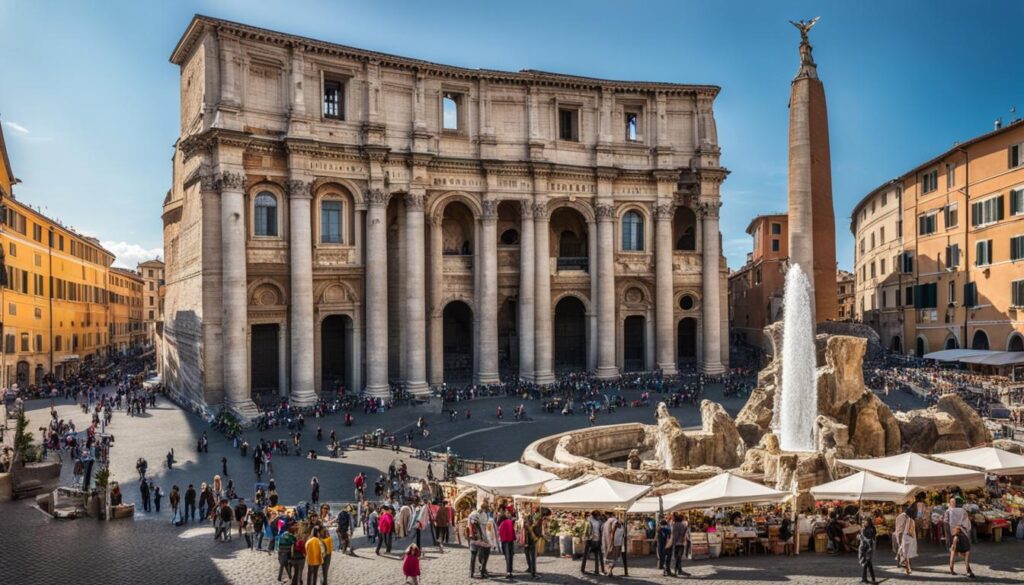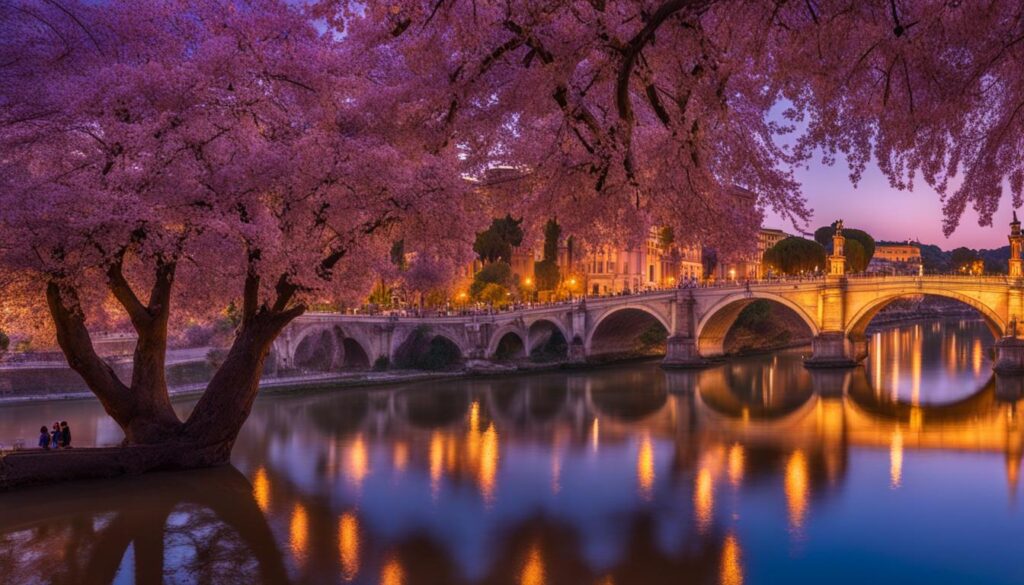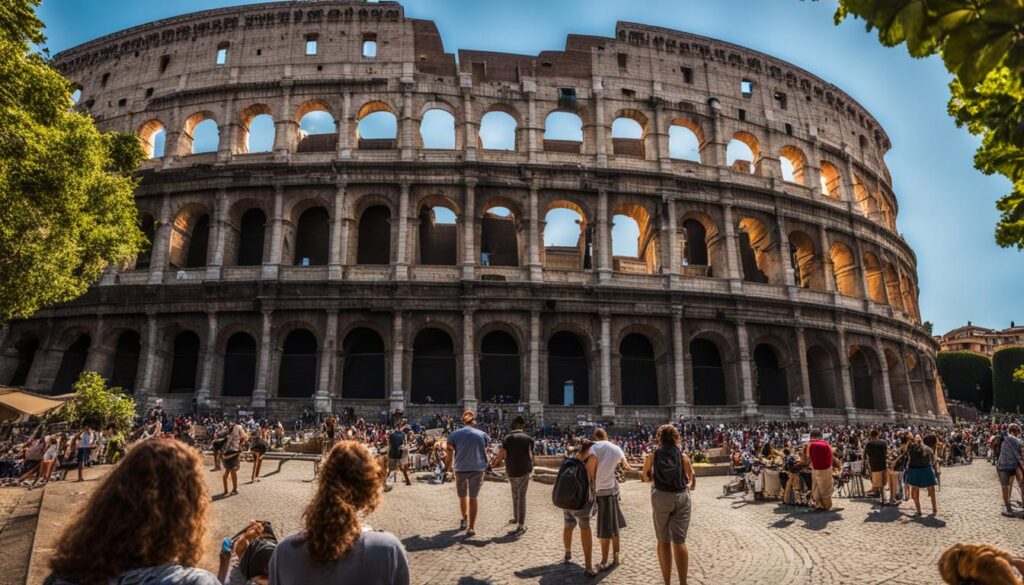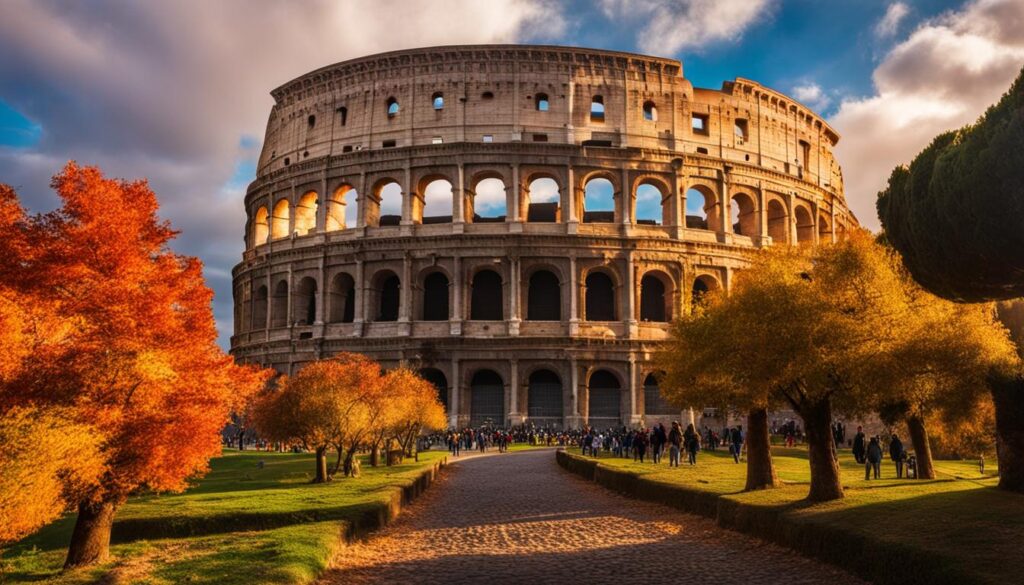Planning a trip to Rome? Choosing the right time of year to visit this amazing city can make all the difference in your overall experience. With ideal weather conditions, fewer crowds, and unique events taking place throughout the year, Rome is a destination that is worth visiting no matter the season. In this section, we will explore the question of what is the best time of year to visit Rome, taking into account the various factors that can impact your trip.
When it comes to Rome travel season, the best months to visit Rome can depend greatly on your personal preferences and interests. Whether you prefer the hustle and bustle of peak tourist season or a quieter, more off-peak travel experience, we will discuss the pros and cons of visiting Rome during different times of the year.
So, what is the best time of year to visit Rome? Let’s explore together and discover how to make the most out of your Roman holiday.
Rome Weather by Month
Understanding the weather in Rome is crucial when planning your trip. The city experiences a Mediterranean climate with hot, dry summers and mild, rainy winters. However, there are variations throughout the year that can impact your experience.
March, April, May
Spring is a popular time to visit Rome, with mild temperatures and blooming flowers. Expect average highs in the mid-60s to low 70s°F (16-22°C) and lows in the 40s to 50s°F (5-15°C). However, it can rain frequently in March and April, so be sure to pack an umbrella.
June, July, August
The summer months bring hot temperatures, with average highs in the mid to high 80s°F (30°C) and lows in the 60s°F (15-20°C). It can also be dry, with little rainfall. Keep in mind that the city can be crowded and uncomfortable during this time, so be sure to stay hydrated and avoid sightseeing during peak sun hours.
September, October, November
Autumn is another popular time to visit Rome, with mild temperatures and colorful foliage. Expect average highs in the mid-60s to low 70s°F (16-22°C) and lows in the 40s to 50s°F (5-15°C). Rainfall can increase in November, so be sure to pack waterproof gear if you plan to visit during this time.
December, January, February
Winter in Rome can be cold and damp, with average highs in the low 50s to mid 50s°F (11-13°C) and lows in the 30s to 40s°F (-1-5°C). However, the city can be beautiful during the holiday season, with festive decorations and events. Just be sure to pack warm clothing and waterproof gear.
Overall, the best time to visit Rome depends on your preferences and priorities. If you don’t mind the crowds and heat, summer can be a great time to explore the city. However, if you prefer mild weather and fewer tourists, spring and autumn may be more your style. Just be sure to check the weather forecast before you go and pack accordingly.
Rome Tourist Season
If you’re planning a trip to Rome, it’s essential to consider the tourist season. Rome attracts visitors year-round, but some months see a higher influx of tourists than others. The peak tourist season in Rome is from June to August and around the Christmas holidays. During these months, the city is bustling with tourists, and the popular attractions and landmarks can get crowded, making it challenging to enjoy your visit fully.
However, if you prefer a vibrant and bustling atmosphere, you will enjoy visiting during peak tourist season. It’s better to make reservations for accommodations, restaurants, and tickets to popular sites in advance, so you don’t get caught up in long lines or risk missing out on your desired experience.
If you prefer a quieter ambiance and avoid crowds, plan your trip during the shoulder season. The ideal time to visit Rome is from April to May or September to October, avoiding the peak tourist season, and still enjoying mild weather. During these months, you can explore the city’s landmarks and museums in a more relaxed atmosphere and have an easier time finding available accommodations or tables at restaurants.
“The ideal time to visit Rome is from April to May or September to October, avoiding the peak tourist season, and still enjoying mild weather.”
Springtime in Rome
Spring is one of the best times to visit Rome. The weather is mild, with temperatures ranging from 63°F (17°C) in March to 75°F (24°C) in May, making it ideal for sightseeing. The city is also less crowded, and you can avoid the long lines at major attractions.
The highlight of spring in Rome is undoubtedly Easter, when the city comes alive with religious processions and celebrations. The most famous event is the Papal Mass at Saint Peter’s Basilica on Easter Sunday, which attracts thousands of visitors from around the world. Another notable event is the Natale di Roma, or Rome’s Birthday, which falls on April 21st and features parades, concerts, and historical reenactments.
If you’re an art lover, spring is the perfect time to visit Rome’s museums and galleries. The Vatican Museums and the Galleria Borghese are two of the most popular attractions, but there are many others worth exploring. You can also take a stroll through the city’s beautiful parks and gardens, including Villa Borghese and the Orto Botanico di Roma.
Month-by-Month Guide
| Month | Average Temperature | Events and Festivals |
|---|---|---|
| March | 63°F (17°C) | Rome Marathon, Festa della Donna |
| April | 69°F (21°C) | Easter, Natale di Roma, Rome Film Fest |
| May | 75°F (24°C) | Corsa dei Ceri, Festival of San Giovanni |
As you can see, each month in spring has its own unique events and attractions. Whether you’re interested in history, art, or simply enjoying the sunshine, there’s something for everyone in Rome during the spring.
Rome in the Summer: Ideal Time to Visit for Sightseeing
Summer is a popular time for tourists to visit Rome, and for good reason. The warm weather and long days make it an ideal time to explore the city’s top attractions and historical landmarks. However, keep in mind that the summer months of June, July, and August are the hottest and most crowded, which means you may have to contend with longer lines and higher prices.
If you do decide to visit Rome during the summer, make sure to prepare for the heat by wearing light clothing and packing sunscreen and a hat. You may also want to plan your sightseeing for early in the morning or late in the evening, when the weather is cooler.
| Pros | Cons |
|---|---|
| Longer days mean more time for sightseeing | Higher prices for hotels and attractions |
| Warm weather is great for outdoor activities | Crowds and long lines at popular tourist sites |
| Many festivals and events | Heat and humidity can be uncomfortable |
Despite the challenges, summer is a great time to experience Rome’s cultural heritage and outdoor attractions. You can catch open-air concerts, theater performances, and festivals, such as the Roman Summer Festival, which takes place from June to September. You can also explore the city’s beautiful parks and gardens, such as the Villa Borghese Gardens and the Appian Way Regional Park.
Overall, if you’re willing to brave the crowds and heat, summer can be an ideal time to visit Rome for sightseeing and outdoor activities. Just make sure to plan ahead and take precautions to ensure a comfortable and enjoyable trip.
Rome in Autumn: The Ideal Time to Visit
If you’re looking for the ideal time to visit Rome, consider planning your trip during the autumn season. September, October, and November offer some of the best weather conditions and unique experiences that attract tourists from around the world.
The weather during autumn is pleasantly mild, with temperatures ranging from 15-25 degrees Celsius. You’ll enjoy comfortable sightseeing without the intense heat of summer or the chill of winter. Additionally, the autumn foliage provides a stunning backdrop for photos, especially in Rome’s parks and gardens.
“Autumn is a second spring when every leaf is a flower.” – Albert Camus
One of the main events during autumn in Rome is the “Notti Bianche,” or White Nights Festival. This cultural event takes place in October and features various music performances, art exhibitions, and guided tours of the city’s architectural treasures. It’s a unique way to experience the city’s rich cultural heritage.
Another reason why autumn is the ideal time to visit is that the crowds have thinned out from the summer tourist season, making it easier to navigate the city’s popular attractions. You’ll also find that prices for flights and accommodations are lower during this time compared to the peak season.
The Pros and Cons of Visiting Rome in Autumn
To summarize, here are some pros and cons of visiting Rome in autumn:
| Pros | Cons |
|---|---|
| Mild weather and beautiful foliage | Slightly shorter daylight hours |
| Cultural festivals and events | School holidays and potential crowds during some weeks |
| Lower prices for flights and accommodations | Possible rainy days |
Overall, autumn provides a great opportunity to experience Rome’s beauty and history with fewer crowds and lower prices, favorable weather, and unique cultural events. It’s the perfect time to plan your Roman holiday.
Winter in Rome
Winter in Rome, from December to February, can offer a unique, magical experience for those who enjoy cooler temperatures, festive celebrations, and indoor attractions. While Rome is generally milder in winter than other European capitals, the average high temperature in December is 57°F (14°C), with lows around 39°F (4°C). January is slightly cooler, with highs averaging 53°F (12°C) and lows around 36°F (2°C), while February starts to show signs of spring, with average highs of 57°F (14°C) and lows of 39°F (4°C).
If you don’t mind bundling up, winter can be an ideal time to visit Rome. The city is less crowded, and you can enjoy popular attractions at a more leisurely pace. You can also save money on accommodations and flights as prices tend to be lower during the off-peak season.
During the winter months, you can still enjoy sightseeing in Rome, especially in the sunshine. You can visit famous landmarks such as the Colosseum, the Roman Forum, and the Vatican without the usual crowds. Moreover, winter is an ideal time to explore Rome’s indoor attractions, such as the Vatican Museums, the Capitoline Museums, and the Galleria Borghese, which can be crowded in the peak season.
| Month | Average High (°F) | Average Low (°F) |
|---|---|---|
| December | 57 | 39 |
| January | 53 | 36 |
| February | 57 | 39 |
If you plan to visit Rome during the winter, make sure to pack warm clothing, including a coat, hat, gloves, and scarf. The weather can be unpredictable, so it’s wise to bring along waterproof shoes and an umbrella. You may also want to check the opening hours of specific attractions, as some may have shorter hours or be closed on certain days during the winter months.
In conclusion, winter can be an ideal time to visit Rome for those who don’t mind cool temperatures and want to avoid crowds. The city is full of indoor attractions, and the festive season adds to the charm of the Eternal City. Whether you’re exploring famous landmarks or enjoying the city’s museums and galleries, Rome has plenty to offer visitors during the winter months.
Rome Off-Peak Travel: When to Visit for Savings and Quiet Ambiance
If you’re looking to save on travel expenses and experience a more relaxed, less crowded atmosphere, visiting Rome during the off-peak travel season may be your best bet. The off-peak season in Rome typically runs from November to March, excluding the Christmas and New Year’s holidays. During this time, you can enjoy many of the city’s attractions without the long lines and crowds that accompany peak season travel.
The Advantages of Rome Off-Peak Travel
Visiting Rome during the off-peak season can offer several benefits:
- Lower prices on flights and accommodations
- Reduced wait times at popular attractions and restaurants
- More availability at hotels and restaurants
- A quieter, more relaxed atmosphere for exploring the city
While the weather may be cooler during the off-peak season, it can still be an enjoyable time to visit Rome. You can take advantage of the city’s indoor attractions, such as museums and galleries, and enjoy the festive atmosphere during the winter holiday season.
When to Visit for Off-Peak Travel to Rome
If you’re looking for the best time for off-peak travel to Rome, consider visiting from November to mid-December or from January to March. These months can offer the best savings, with lower prices on flights and accommodations. Additionally, you’ll be able to take advantage of the quieter ambiance and fewer crowds.
Keep in mind that the Christmas and New Year’s holidays can be busy and expensive times to travel to Rome, so it may be best to avoid these weeks if possible.
Planning Your Rome Off-Peak Travel
When planning your trip to Rome during the off-peak season, be sure to consider the weather conditions and plan accordingly. Pack warm clothing and be prepared for rain, as the winter months can be damp in Rome.
You may also want to research the indoor attractions and events happening in the city during your visit, as these can be great options for staying dry and warm during chilly weather.
Finally, be sure to book your travel and accommodations well in advance to take advantage of the best prices and availability.
Rome Travel Tips: Planning Your Trip
Planning a trip to Rome involves many factors, including the timing of your vacation. To make the most of your Roman holiday, consider these travel tips:
Choose the Best Time for Your Interests
Rome has something to offer year-round, but each season and month presents unique experiences. Consider your preferences and interests when deciding on the best time to visit. If you enjoy outdoor activities, such as long walks through the city’s parks or spacious piazzas, spring is an ideal time when the weather is mild and the flowers are in bloom. However, if you want to see the city at its most festive, plan a trip in December when many holiday events take place.
Take Advantage of Off-Peak Travel
If you prefer to avoid crowds and save costs, consider visiting Rome during the off-peak travel season. The months of November through March have fewer tourists, and many attractions offer lower rates during this time. You can also enjoy a quieter ambiance and more intimate experiences.
Check the Weather Forecast
Before packing for your trip, check the weather forecast for Rome. The city’s climate can be unpredictable, with sudden rainstorms or heatwaves. Pack accordingly, bringing comfortable walking shoes, sunscreen, and a light jacket or umbrella.
Book Popular Attractions in Advance
Many of Rome’s popular attractions, such as the Colosseum and the Vatican Museums, have long lines and require advance reservations. To avoid waiting in line or missing out on visiting a site altogether, book tickets in advance. Additionally, consider booking a guided tour to gain in-depth knowledge and insights into these historic sites.
Stay in Central Locations
Choosing a centrally located hotel or apartment can save you time and money on transportation. Many of Rome’s top attractions are within walking distance, and the city’s public transportation can be crowded and confusing for first-time visitors.
Conclusion
Deciding on the best time to visit Rome depends on your preferences and desired experiences. Understanding the different seasons and timing considerations can help you plan an unforgettable trip to the Eternal City.
Ideal time to visit Rome
For pleasant weather and fewer crowds, the ideal time to visit Rome is during the off-peak travel season. From November to February, you can enjoy Rome’s indoor attractions, festive celebrations, and potentially save costs on travel and accommodations.
However, if you prefer the hustle and bustle of peak tourist season, plan your visit between June to August. You’ll experience the best of Rome’s outdoor attractions and vibrant atmosphere, but expect higher temperatures and larger crowds.
Rome travel season
The Rome travel season generally spans from March to October, with peak tourist season between June to August. However, with proper planning and research, you can make the most of Rome’s attractions and ambiance year-round.
Rome tourist season
If you’re visiting Rome during the peak tourist season, be prepared for larger crowds and longer wait times at popular attractions. Consider booking tours and tickets in advance, and arrive early to avoid the midday rush.
Rome sightseeing during different seasons
Depending on the time of year you visit, you can experience Rome’s attractions and ambiance in unique ways. From the springtime cherry blossoms and outdoor festivals to the winter holiday markets and indoor museums, every season has something special to offer.
When planning your trip, consider the weather conditions and desired experiences to help you decide the best time to visit Rome. With proper planning and flexibility, you can discover the enchanting beauty of the Eternal City year-round.
















































